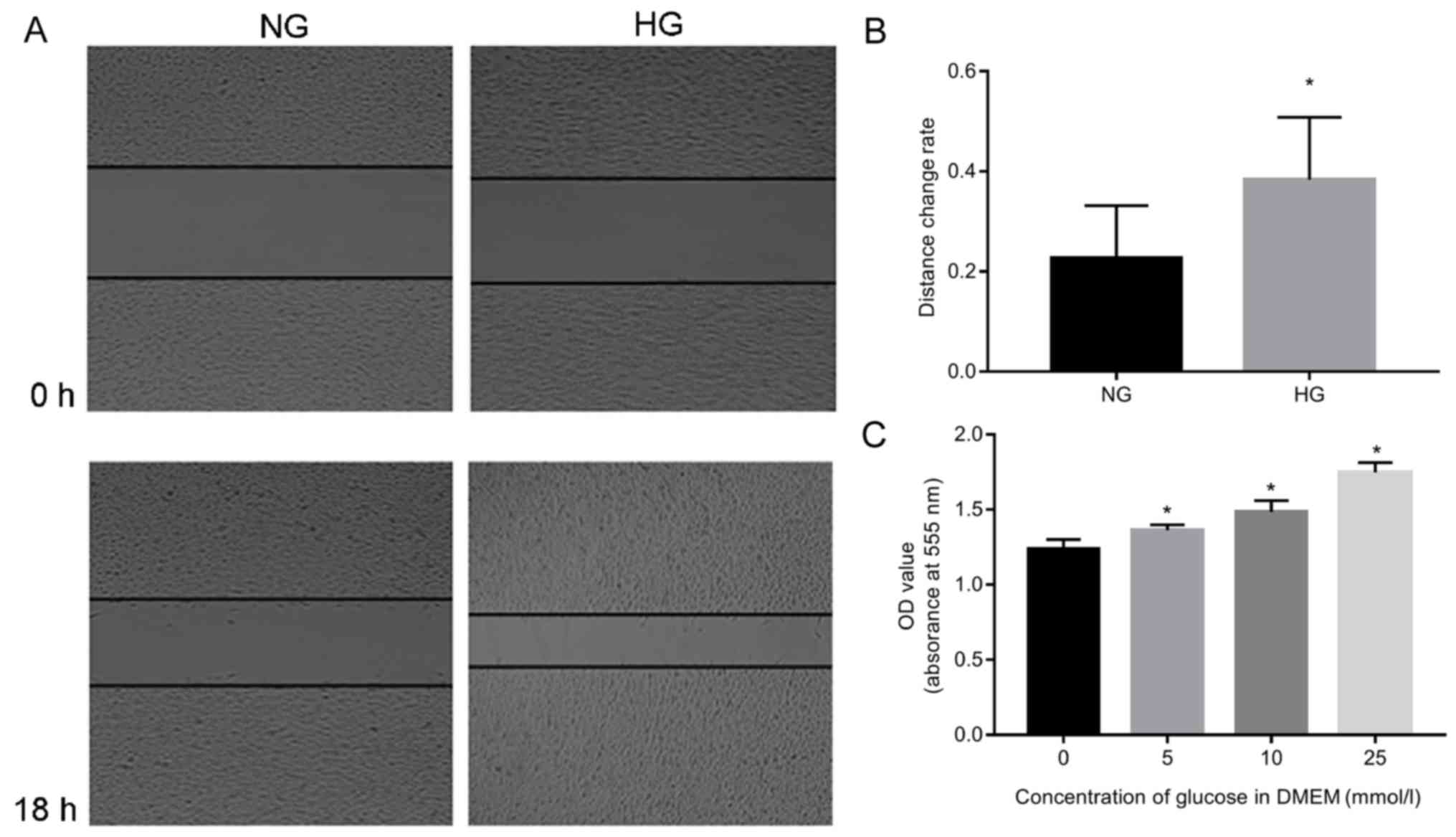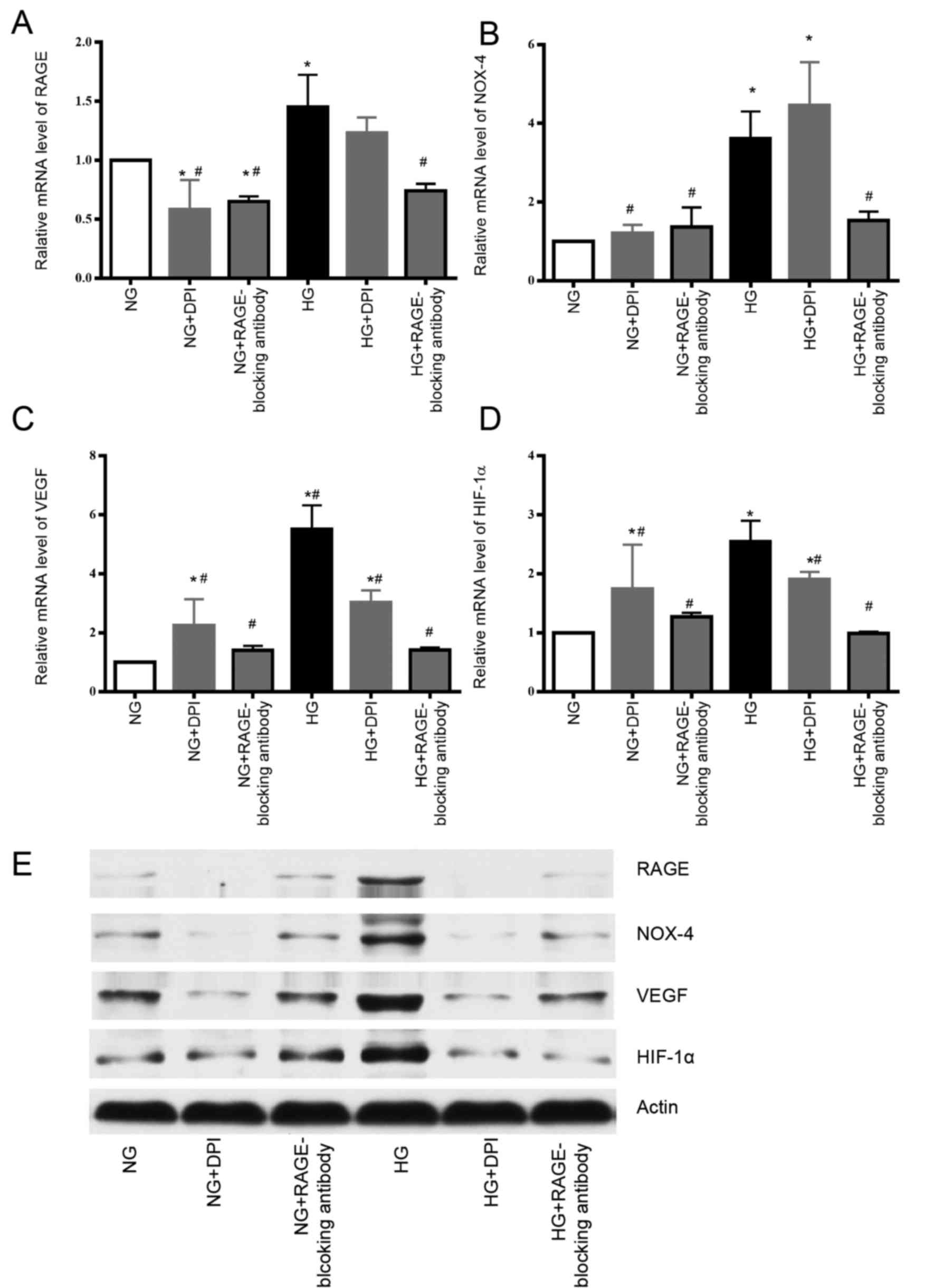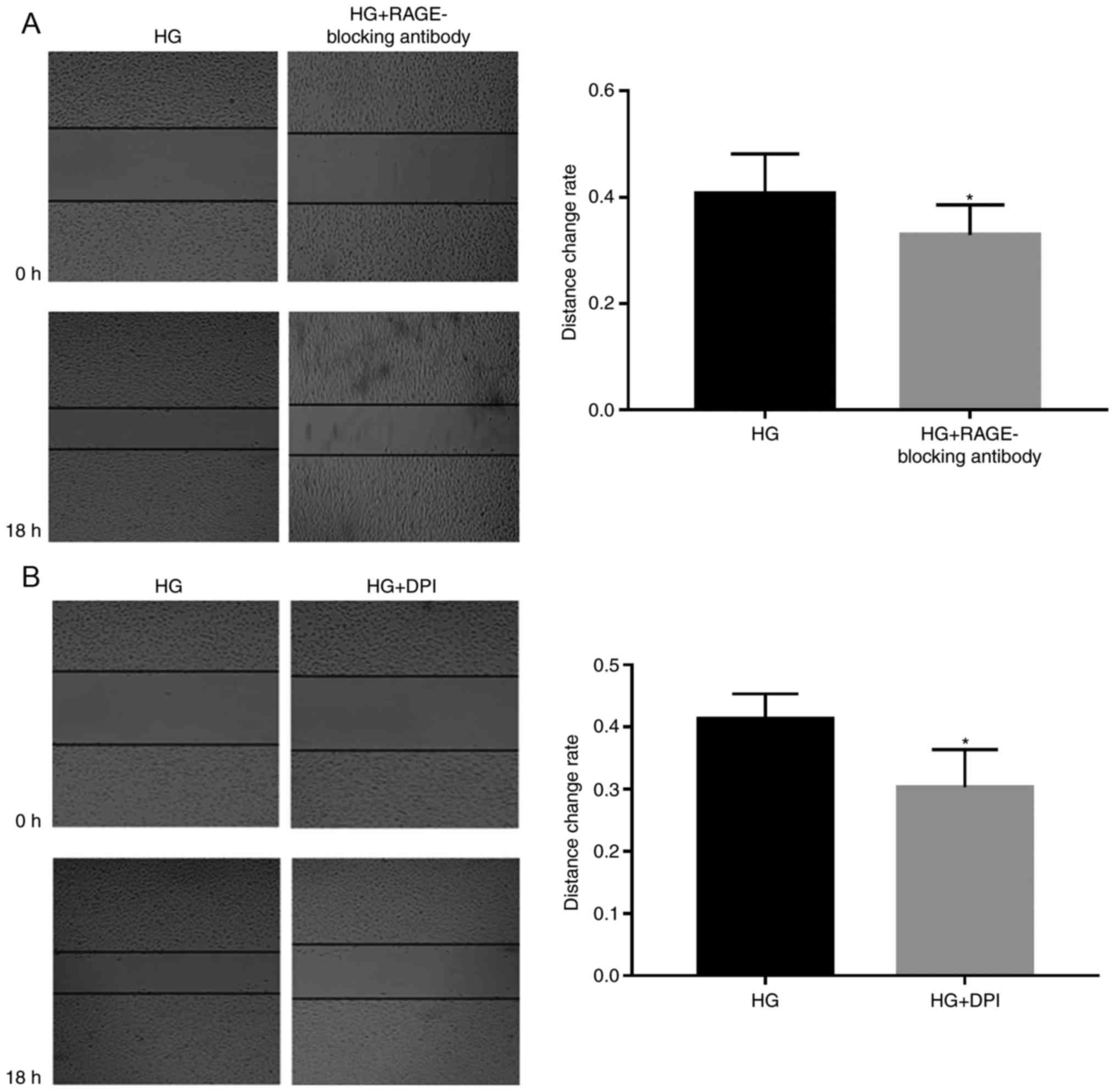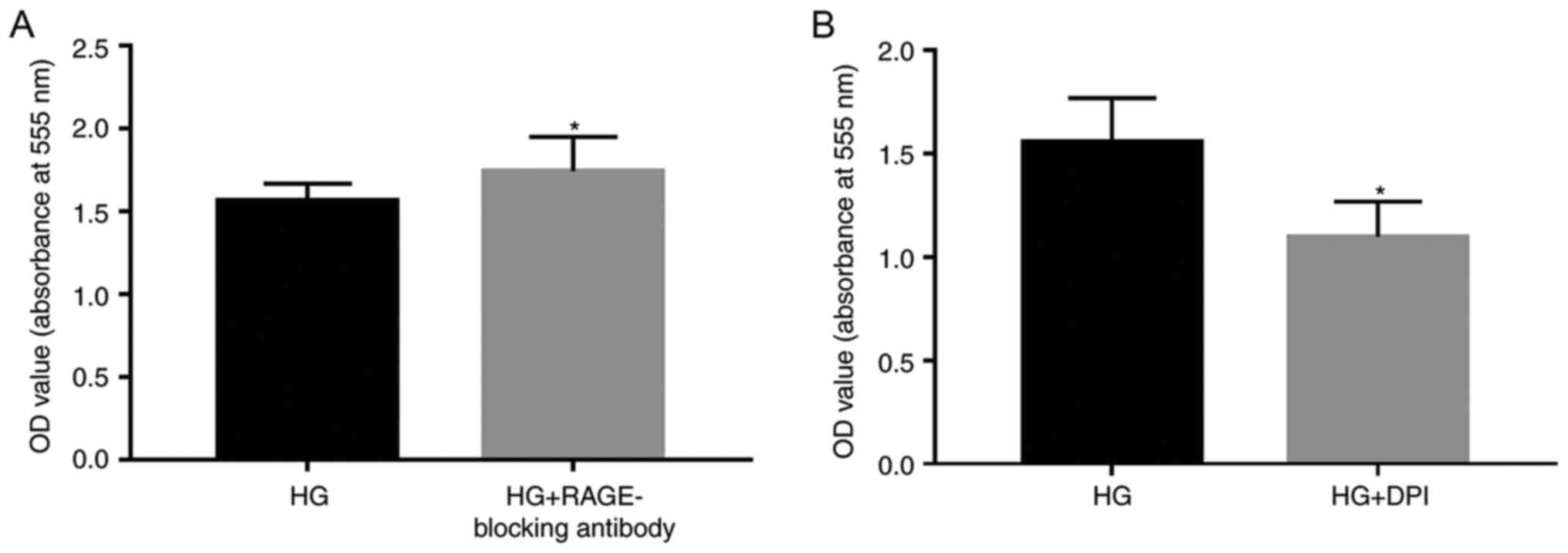High glucose promotes tumor cell proliferation and migration in lung adenocarcinoma via the RAGE‑NOXs pathway
Corrigendum in: /10.3892/mmr.2018.9555
- Authors:
- Published online on: April 23, 2018 https://doi.org/10.3892/mmr.2018.8914
- Pages: 8536-8541
Abstract
Introduction
Lung carcinoma is a prevalent disease, which is associated with a marked impact on global health and an increasing rate of incidence (1). Tobacco smoking and environmental tobacco smoke, genetic factors, air pollution, and certain occupational exposures, including to asbestos and radon, are considered high risk factors for lung cancer (2–4). Accumulating evidence has suggested that there is an association between diabetes and lung cancer (5–7). In certain clinical trials, the combination of diabetes and lung cancer has been associated with an elevated mortality rate (8), whereas antidiabetic medication can improve the survival rate among such patients (9). In vitro, a high concentration of glucose (HG) has been demonstrated to promote the invasion and metastatic potential of A549 cells (10). These data indicate the potential association between diabetes and lung cancer.
Receptor for advanced glycation end-products (RAGE, also known as AGER), the ligands of which were initially identified as advanced glycation end products, serves a role in diabetes mellitus. RAGE has been reported to be downregulated in non-small cell lung cancer (NSCLC) (11–13), which differs from other solid tumors, including liver cancer, which exhibit high levels of RAGE (14). In the present study, the potential role of RAGE in the effects of HG on A549 cells was investigated.
Nicotinamide adenine dinucleotide phosphate oxidase (NOX)-4 is a member of the NOX family, which is associated with generation of endogenous reactive oxygen species (ROS) and mediation of inflammatory responses (15). The NOX-4 protein may also be an intermediary agent in the association between RAGE and inflammation, which may influence the tumor cell microenvironment (16). Both RAGE and NOXs mediate the chronic inflammatory response, which may potentially increase the risk of carcinogenesis; however, whether there is an association between the factors remains largely unknown. The present study aimed to clarify the possible mechanism of how glucose affects the growth and migration of cancer cells. Therefore, affecting glucose metabolism may be a potential target to suppress cancer cells, which would avoid the side effects that occur with the use of hypoglycemic drugs such as melamine.
Materials and methods
Cell culture
Human lung adenocarcinoma A549 cells, purchased from Shanghai Institute of Cell Biology of the Chinese Academy of Sciences (Shanghai, China), were cultured in Dulbecco's modified Eagle's medium (DMEM; Servicebio, Inc., Woburn, MA, USA), for 24 h, supplemented with 10% fetal bovine serum (FBS; Servicebio, Inc.), 25 mmol/l glucose in the HG group or 5.5 mmol/l glucose in the normal concentration of glucose (NG) group, and 100 U/ml penicillin at 37°C in a humidified atmosphere containing 5% CO2. The cells were used between passages 6 and 10.
NOX inhibitor and RAGE-blocking antibody
The NOX inhibitor diphenyl iodonium chloride (DPI) was purchased from Tocris Bioscience (Bristol, UK; no. 4673-26-1) and was dissolved in dimethyl sulfoxide (DMSO), in order to provide a final concentration of 5 µM, which was stored at 4°C. RAGE affinity-purified antibody (5 µg/ml; cat. no. PB0530; Boster Biological Technology, Pleasanton, CA, USA) was dissolved in PBS, and used as a RAGE-blocking antibody.
Cell proliferation and viability
Cell proliferation and viability were assessed using an MTT assay. The cells were seeded at a density of 2×103 cells/well (in 5% FBS) or 5×103 cells/well (in 0.2% FBS) onto 96-well plates in 100 µl DMEM overnight, after which the medium was removed. Following treatment with different concentrations of glucose (0, 5, 10 and 25 mmol/l), with or without 5 µM DPI or 5 µg/ml RAGE-blocking antibody for 24 h, 20 µl MTT solution (5 mg/ml; Servicebio, Inc.) was added and the cells were cultured for a further 4 h. Subsequently, the medium was removed and 150 µl DMSO was added to dissolve the purple formazan for 5–10 min. Absorbance was measured at a wavelength of 555 nm using an ELISA plate reader.
Cell migration assay
Cell migration was examined by wound-healing assay. Following treatment with HG or NG, with or without 5 µM DPI or 5 µg/ml RAGE-blocking antibody for 24 h, A549 cells were seeded on 6-well plates at a density of 5×103/well and a straight scratch was made using a 200-µl sterile pipette tip. Subsequently, the 6-well plates were washed with PBS three times and fresh medium was added. After 18 h, migration was determined by comparing the wound area between the NG group and the HG group under an inverse fluorescent microscope. Distance change rate was calculated by initial distance-final distance/initial distance.
RNA extraction, cDNA synthesis and qPCR
The cells were plated at a density of 1.5×105 cells/well in 12-well plates and were cultured for 24 h after treated with HG or NG. Total RNA was extracted using RNA rapid extraction solution (Servicebio, Inc.), according to the manufacturer's protocol. The quality and quantity of isolated total RNA were assessed using a NanoDrop™ 2000 Spectrophotometer (NanoDrop; Thermo Fisher Scientific, Inc., Wilmington, DE, USA). RNA was reverse transcribed to cDNA using a RevertAid First Strand cDNA Synthesis kit (Thermo Fisher Scientific, Inc., Waltham, MA, USA) according to the manufacturer's protocol. FastStart Universal SYBR-Green Master (Rox) (Roche Diagnostics, Basel, Switzerland) was used for qPCR analysis, according to the manufacturer's protocol. Fluorescence detection was conducted using an ABI StepOne Plus Real-Time PCR system (Applied Biosystems; Thermo Fisher Scientific, Inc., Waltham, MA, USA). The 2−∆∆Cq method was used to quantify the expression levels of target genes (17). The following primers were used in the present study (all 5′→3′): β-actin forward, CACCCAGCACAATGAAGATCAAGAT and reverse, CCAGTTTTTAAATCCTGAGTCAAGC; RAGE forward, CACTGGTGCTGAAGTGTAAGGG and reverse, CGGACTCGGTAGTTGGACTTG; NOX-4 forward, ATTTAGATACCCACCCTCCCG and reverse, CACAGTACAGGCACAAAGGTCC; hypoxia-inducible factor-1α (HIF-1α) forward, TGATTGCATCTCCATCTCCTACC and reverse, GACTCAAAGCGACAGATAACACG; and vascular endothelial growth factor (VEGF) forward, GGAGGGCAGAATCATCACGA and reverse, GACTCAAAGCGACAGATAACACG. Actin RNA levels were used as an endogenous control.
Western blot analysis
The cells were plated at a density of 1.5×105 cells/well in 6-well plates and cultured for 24 h. The media were subsequently removed and fresh media containing NG or HG, with or without DPI (5 µM) or RAGE-blocking antibody (5 µg/ml), were added for 24 h. Total protein was extracted with a RIPA Lysis Buffer (Servicebio, Inc.), according to the manufacturer's protocol. Proteins (20 µg) were separated by 10% SDS-PAGE and transferred onto polyvinylidene fluoride membranes. Following blocking by 5% milk, made with skim milk powder (YIli, China) and Tris Buffered saline Tween buffer (0.1% Tween), at normal temperature for 1 h, monoclonal primary antibodies, namely anti-RAGE antibody (1:500; cat. no. PB0530; Wuhan Boster Biological Technology, Ltd., Wuhan, China), anti-NOX-4 antibody (1:1,000; cat. no. ab109225; Abcam), anti-VEGF antibody (1:500; cat. no. GB11034), anti-HIF-1α antibody (1:1,000, rabbit; cat. no. GB11031) and anti-β-actin antibody (1:2,000; cat. no. GB13001-3; all Servicebio, Inc.), were added and incubated overnight at 37°C. Subsequently, the membranes were washed five times by Tris Buffered saline Tween buffer, and incubated with a goat anti-rabbit immunoglobulin G horseradish peroxidase-conjugated secondary antibody (1:3,000; cat. no. GB23303; Servicebio, Inc.) for 55 min. The membranes were subsequently washed five times by Tris Buffered saline Tween buffer. Finally, the protein bands were detected using an EPSON Perfection V300 Photo scanner (Seiko Epson Corporation, Suwa, Japan) after processing with E Enhanced Chemiluminescence visualization reagent (G2014; Servicebio, Inc.).
Statistical analysis
Data are presented as the means ± standard error of the mean of three repeat. Unpaired t-test was selected to compare two groups, and analyses of multiple groups were performed using one-way analysis of variance, followed by least-significant-difference post hoc test. Analysis was performed using SPSS 22.0 software (IBM Corp., Armonk, NY, USA). P<0.05 was considered to indicate a statistically significant difference.
Results
HG promotes proliferation and migration of A549 cells, and increases the mRNA and protein expression levels of RAGE and NOX-4
The present study determined how various concentrations of glucose affected the proliferation and migration of A549 cells (Fig. 1). The results demonstrated that A549 cells survived well in response to glucose, and increased proliferation was detected when the concentration of glucose was increased (P<0.05; Fig. 1A and B). The migration rate increased significantly in the HG group compared to NC (P<0.05; Fig. 1C).
Subsequently, 5 µg/ml RAGE-blocking antibody and 5 µM DPI were added to the cells, in order to investigate whether RAGE and NOXs serve roles in HG-induced effects (Figs. 2–4). RAGE-blocking antibody inhibited the protein and mRNA expression levels of RAGE and NOX-4 under HG condition, which has the ability to promote the expression of the mRNA and protein of the RAGE and NOX-4 (Fig. 2A and B). Furthermore, treatment with RAGE-blocking antibody accelerated the proliferation (P<0.05; Fig. 3A) and suppressed HG-induced migration (P<0.05; Fig. 4A) of A549 cells, thus indicating that RAGE-blocking antibody may reverse HG-induced effects on cell metastasis. Similar effects were detected in cells treated with the NOX inhibitor DPI; briefly, HG-induced proliferation (P<0.05; Fig. 3B) and migration (P<0.05; Fig. 4B) of A549 cells were inhibited by DPI, which also suppressed the protein expression levels of NOX-4, (Fig. 2E) while having no significant effect on the mRNA expression levels of RAGE (Fig. 2A).
RAGE-blocking antibody and DPI inhibit the expression of HIF-1α and VEGF, which are involved in mediating tumorigenesis, tumor growth and cancer metastasis
Finally, to determine how the RAGE-NOX-4 pathway affects the biological functions of tumor cells, variations in the expression levels of VEGF and HIF-1α were measured when RAGE and NOX-4 were suppressed by their respective inhibitors. The mRNA and protein expression levels of VEGF and HIF-1α were increased under HG conditions compared with NG, whereas treatment with the RAGE-blocking antibody and DPI reduced the expression levels of VEGF and HIF-1α, which indicated that these inflammatory factors may be downstream effectors in the glucose-associated cellular pathways (Fig. 2C-E). However, the mechanism by which the RAGE-blocking antibody and DPI act on VEGF and HIF-1α in the NG groups, remain unclear.
Discussion
The constant increase in diabetes mellitus-associated morbidity between 2002 and 2012 indicates that the occurrence of diabetes is associated with a diverse range of complications, which further increases the public health threat posed by this disease (18). Furthermore, recent studies have suggested that a pre-existing hyperglycemic condition, together with the time of diagnosis and insulin deficiency, may exert negative effects on patient prognosis and contribute to the local recurrence of a pulmonary neoplasm by impacting the signaling pathways of cancer cells (5,6). This viewpoint has been verified by another study, which demonstrated that metformin may improve the chemotherapy outcomes and survival rate of patients presenting with both diabetes and lung carcinoma in a dose-dependent manner (19). The present study confirmed that HG may promote the proliferation and migration of the human NSCLC cell line A549 in a dose-dependent manner, thus indicating that HG may be a risk factor not only for metastasis, but also for the growth of lung adenocarcinoma tumor mass.
RAGE, which is a member of the immunoglobulin superfamily, is a pattern recognition receptor that can bind a diverse range of ligands with similar three-dimensional structures (12). Since the identification of RAGE on endothelial cells, the role of RAGE has gradually been established in certain pathological processes associated with chronic inflammation, including asthma, lung cancer and chronic obstructive pulmonary disease. It has previously been reported that RAGE exhibits acceleration of the growth and metastasis of pulmonary solid tumor tissue (20). Nevertheless, the signaling pathways of RAGE are yet to be elucidated. The results of the present study demonstrated that RAGE may be a protective factor in the growth of lung adenocarcinoma tumor tissues, but a potential risk factor for metastasis. Furthermore, its expression was increased in response to HG exposure; therefore, it may be hypothesized that RAGE potentially participates in HG-induced oxidative stress via activating NOXs.
NOXs are multi-protein complexes that give rise to the generation of ROS, which can in turn mediate oxidative stress and inflammatory responses (21). The effect of NOXs on ROS generation can also be initiated by HG, thus suggesting that an association may exist between NOXs and HG. In addition, NOXs may facilitate the proliferation and migration of tumor cells by activating certain signaling pathways, including nuclear factor-κB signaling (22). In the present study, NOX-4, a member of the NOX family, was induced in response to HG; it was suggested that this effect was mediated by RAGE in lung adenocarcinoma cells. Furthermore, the NOX inhibitor DPI served as a protective agent in HG-induced proliferation and migration of A549 cells. These results revealed a potential mechanism underlying HG-induced ROS production via the RAGE-NOX-4 pathway.
Overexpression of HIF-1α has been observed in various types of solid tumors, and through its corresponding nuclear receptor, HIF-1α may regulate genes involved in cancer progression, and subsequently promote the proliferation and invasion of lung carcinoma cells (23). VEGF is a protein that mediates angiogenesis and, in turn, sustains the growth of tumor tissue; therefore, the abnormal expression of this factor may have a stimulatory effect on cancer development (24). In addition, VEGF and HIF-1α are associated with tumor growth and metastasis in various pathways, and are likely associated with the poor prognosis of patients. The present study unveiled a potential approach for controlling the expression of these factors through obstructing the glucose-RAGE-NOX-4 pathway, in order to ultimately inhibit tumor progression.
In conclusion, abnormal glucose metabolism is a pathological factor facilitating the oncogenic and biological behavior of lung cancer cells, which likely occurs through activation of the RAGE-NOX-4 pathway, and subsequent upregulation of VEGF and HIF-1α. Through binding of these inflammatory factors to their corresponding receptors to exert their specific biological effects, cancer cells may grow faster and their malignancies may be enhanced. Therefore, the significance of controlling blood glucose levels in patients with lung cancer combined with diabetes is evident, and RAGE and/or NOXs may be potential therapeutic targets for the treatment of patients with lung adenocarcinoma and comorbid diabetes. However, the method of administering antagonists rather than performing gene silencing may not be the preferred plan, due to its inconsistent effects during the present study. In addition, why the RAGE-blocking antibody promoted HG-induced proliferation of A549 cells, and whether RAGE-NOXs mediate other effects, as well as inducing the expression of VEGF and HIF-1α, remain unknown; therefore, we aim to address these issues in future research.
Acknowledgements
Not applicable.
Funding
The present study was supported by the Wu Jieping Medical Fund of China (grant no. 320.6750.17056).
Availability of data and materials
The data sets used and/or analyzed during the current study are available from the corresponding author on reasonable request.
Authors' contributions
YFL and FL designed and conducted the experiment, data analysis, and conclusion completed jointly by YFL, FL and BZ. The manuscript was produced by YFL and then reviewed and revised by FL and BZ. SY and ZQC participated in part of the experimental process.
Ethics approval and consent to participate
Not applicable.
Consent for publication
Not applicable.
Competing interests
The authors declare that they have no competing interests.
References
|
Zhang Y, Ren JS, Huang HY, Shi JF, Li N, Zhang Y and Dai M: International trends in lung cancer incidence from 1973 to 2007. Cancer Med. Mar 14–2018.(Epub ahead of print). View Article : Google Scholar | |
|
Cigarette smoking among adults-United States, 2006. MMWR Morb Mortal Wkly Rep. 56:1157–1161. 2007.PubMed/NCBI | |
|
Morrison HI, Semenciw RM, Mao Y and Wigle DT: Cancer mortality among a group of fluorspar miners exposed to radon progeny. Am J Epidemiol. 128:1266–1275. 1988. View Article : Google Scholar : PubMed/NCBI | |
|
Spitz MR, Hong WK, Amos CI, Wu X, Schabath MB, Dong Q, Shete S and Etzel CJ: A risk model for prediction of lung cancer. J Natl Cancer Inst. 99:715–726. 2007. View Article : Google Scholar : PubMed/NCBI | |
|
Luo J, Hendryx M, Qi L, Ho GY and Margolis KL: Pre-existing diabetes and lung cancer prognosis. Br J Cancer. 115:76–79. 2016. View Article : Google Scholar : PubMed/NCBI | |
|
Yang X, Liu Y, Mani H, Olson J, Clawson G, Caruso C, Bruggeman R, Varlotto JM, Zander DS and Rassaei N: Biologic evaluation of diabetes and local recurrence in non-small cell lung cancer. Pathol Oncol Res. 23:73–77. 2017. View Article : Google Scholar : PubMed/NCBI | |
|
Zhu L, Cao H, Zhang T, Shen H, Dong W, Wang L and Du J: The effect of diabetes mellitus on lung cancer prognosis: A PRISMA-compliant meta-analysis of Cohort Studies. Medicine (Baltimore). 95:e35282016. View Article : Google Scholar : PubMed/NCBI | |
|
Iachina M, Jakobsen E, Møller H, Lüchtenborg M, Mellemgaard A, Krasnik M and Green A: The effect of different comorbidities on survival of non-small cells lung cancer patients. Lung. 193:291–297. 2015. View Article : Google Scholar : PubMed/NCBI | |
|
Lin JJ, Gallagher EJ, Sigel K, Mhango G, Galsky MD, Smith CB, LeRoith D and Wisnivesky JP: Survival of patients with stage IV lung cancer with diabetes treated with metformin. Am J Respir Crit Care Med. 191:448–454. 2015. View Article : Google Scholar : PubMed/NCBI | |
|
Kang X, Kong F, Wu X, Ren Y, Wu S, Wu K, Jiang Z and Zhang W: High glucose promotes tumor invasion and increases metastasis-associated protein expression in human lung epithelial cells by upregulating heme oxygenase-1 via reactive oxygen species or the TGF-β1/PI3K/Akt signaling pathway. Cell Physiol Biochem. 35:1008–1022. 2015. View Article : Google Scholar : PubMed/NCBI | |
|
Fritz G: RAGE: A single receptor fits multiple ligands. Trends Biochem Sci. 36:625–632. 2011. View Article : Google Scholar : PubMed/NCBI | |
|
Oczypok EA, Perkins TN and Oury TD: All the ‘RAGE’ in lung disease: The receptor for advanced glycation endproducts (RAGE) is a major mediator of pulmonary inflammatory responses. Paediatr Respir Rev. 23:40–49. 2017.PubMed/NCBI | |
|
Wang H, Li Y, Yu W, Ma L, Ji X and Xiao W: Expression of the receptor for advanced glycation end-products and frequency of polymorphism in lung cancer. Oncol Lett. 10:51–60. 2015. View Article : Google Scholar : PubMed/NCBI | |
|
Hollenbach M: The role of Glyoxalase-I (Glo-I), Advanced Glycation Endproducts (AGEs), and their receptor (RAGE) in chronic liver disease and Hepatocellular Carcinoma (HCC). Int J Mol Sci. 18:pii: E2466. 2017. View Article : Google Scholar : PubMed/NCBI | |
|
Tang CT, Lin XL, Wu S, Liang Q, Yang L, Gao YJ and Ge ZZ: NOX4-driven ROS formation regulates proliferation and apoptosis of gastric cancer cells through the GLI1 pathway. Cell Signal. 46:52–63. 2018. View Article : Google Scholar : PubMed/NCBI | |
|
Kim E, Kim W, Lee S, Chun J, Kang J, Park G, Han I, Yang HJ, Youn H and Youn B: TRAF4 promotes lung cancer aggressiveness by modulating tumor microenvironment in normal fibroblasts. Sci Rep. 7:89232017. View Article : Google Scholar : PubMed/NCBI | |
|
Livak KJ and Schmittgen TD: Analysis of relative gene expression data using real-time quantitative PCR and the 2(-Delta Delta C(T)) method. Methods. 25:402–408. 2001. View Article : Google Scholar : PubMed/NCBI | |
|
Mayer-Davis EJ, Dabelea D and Lawrence JM: Incidence trends of type 1 and type 2 diabetes among youths, 2002–2012. N Engl J Med. 377:3012017. View Article : Google Scholar : PubMed/NCBI | |
|
Mazzone PJ, Rai H, Beukemann M, Xu M, Jain A and Sasidhar M: The effect of metformin and thiazolidinedione use on lung cancer in diabetics. BMC Cancer. 12:4102012. View Article : Google Scholar : PubMed/NCBI | |
|
Yu YX, Pan WC and Cheng YF: Silencing of advanced glycosylation and glycosylation and product-specific receptor (RAGE) inhibits the metastasis and growth of non-small cell lung cancer. Am J Transl Res. 9:2760–2774. 2017.PubMed/NCBI | |
|
Souabni H, Ezzine A, Bizouarn T and Baciou L: Functional assembly of soluble and membrane recombinant proteins of mammalian NADPH oxidase complex. Methods Mol Biol. 1635:27–43. 2017. View Article : Google Scholar : PubMed/NCBI | |
|
Auer S, Rinnerthaler M, Bischof J, Streubel MK, Breitenbach-Koller H, Geisberger R, Aigner E, Cadamuro J, Richter K, Sopjani M, et al: The human NADPH oxidase, Nox4, regulates cytoskeletal organization in two cancer cell lines, HepG2 and SH-SY5Y. Front Oncol. 7:1112017. View Article : Google Scholar : PubMed/NCBI | |
|
Yang N, Liang Y, Yang P and Ji F: Propofol suppresses LPS-induced nuclear accumulation of HIF-1α and tumor aggressiveness in non-small cell lung cancer. Oncol Rep. 37:2611–2619. 2017. View Article : Google Scholar : PubMed/NCBI | |
|
Frezzetti D, Gallo M, Maiello MR, D'Alessio A, Esposito C, Chicchinelli N, Normanno N and De Luca A: VEGF as a potential target in lung cancer. Expert Opin Ther Targets. 21:959–966. 2017. View Article : Google Scholar : PubMed/NCBI |













